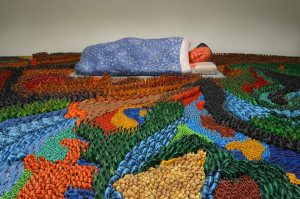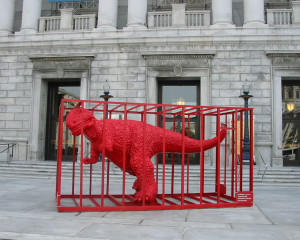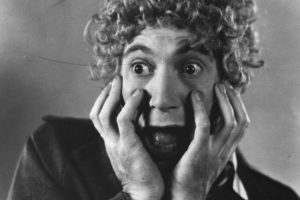The Sleep of Reason: Sui Jianguo at the Asian Art Museum
These reflections were originally published in the San Francisco Bay Guardian. They can be cited here as: Buckner, Clark. “The Sleep of Reason: Sui Jianguo at the Asian Art Museum.” www.clarkbuckner.com. Web. Day, Month, Year the post was accessed.
In his work, the Chinese sculptor Sui Jianguo explores the contradictions in contemporary China, as it turns its back on its recent communist past and rapidly develops a capitalist economy. Outside on the front steps of the Asian Art Museum, Jianguo installed a roughly nine foot high statue of a red toy dinosaur with the words “made in China” printed on its torso. The dinosaur was an enlarged, cheap, plastic export – a paradigm of the ubiquitous Chinese goods that also sit on the shelves of American stores. It presented China’s emerging force as a competitor in international markets, and the threat this presents to the West. But the dinosaur also presented China’s ancient past, and the traditions that, recently, have reappeared as important social forces, challenging the authority of the Communist party, most visibly, in the practice of Falun Gong. At the same time, painted red, the dinosaur presented the Maoist project itself, now caged by the hegemony of international capitalism, but also threatening one day to reappear out of the past.
Like the exhibition title that he borrowed from Goya, the strength of Jianguo’s work is its polyvalence, which enables him to articulate the historical moment as a constellation of contradictions and to explore its significance without inscribing it in a unifying narrative. For the sculptures, “Dying Slave,” and “Bound Slave,” for example, Jianguo reproduced Michelangelo sculptures and dressed them in boxy, militaristic Mao-suits. Curatorial notes suggested that the statues presented the sensual spirit of Western culture, repressed by the strictures of Communist ideology. But the figures more immediately seemed absurd, as if giving voice to the artist’s uncomfortable engagement with Western culture. In “Sleeping Mao,” Jianguo presented the figurehead asleep beneath a blanket at the center of colorful landscape constructed entirely of toy dinosaurs. Is the sleep of reason, Maoism or its passing? Are the monsters it gives birth to the repressed multitudes, China’s past, or the workers now providing cheap labor for Western industry? While rebelling against party-sanctioned social realism, Jianguo simultaneously appears to be wary of capitalist triumphalism. In fact, throughout his work, he continues to engage the central concern of dialectical materialism. That is, the problem of history.





